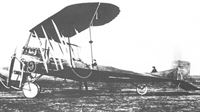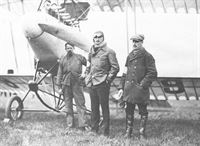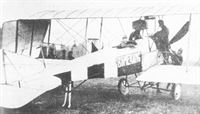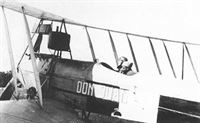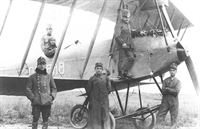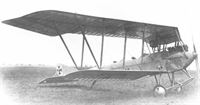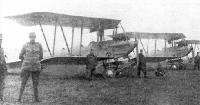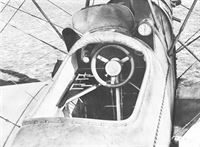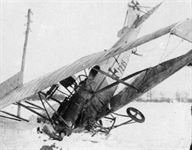
Описание
Страна: Австро-Венгрия
Год: 1912
Фронтовой самолет
В.Кондратьев Самолеты первой мировой войны
ЛЁНЕР B-I/B-II/B-IV/B-VI/B-VII/C-I / LOHNER B-I/B-II/B-IV/B-VI/B-VII/C-I
В 1913 году на венской фирме Якоба Лёнера был разработан двухместный биплан "В" со 120-сильным мотором "Австро-Даймлер" и оригинальными стреловидными крыльями, повышавшими, по замыслу авторов, продольную и поперечную устойчивость машины.
На следующий год его приняли на вооружение австро-венгерской военной авиации, присвоив обозначение В-l. При этом вначале каждая построенная машина, подобно боевому кораблю, имела собственное имя, начинавшееся с буквы "Б" ("Бригант", "Барбара", "Будда", "Бригитта" и т.д.).
На раннем этапе Первой мировой войны характеристики B-I вполне удовлетворяли военных, и самолет с успехом применялся на сербско-австрийском и русско-австрийском фронтах. Аппараты данного типа, в частности, осуществляли связь с гарнизоном осажденной русскими войсками крепости Перемышль.
В 1915-1916 годах семейство "Лёнеров" пополнилось целым рядом дальнейших модификаций, также выпускавшихся серийно и состоявших на вооружении.
С начала 1916 года две последние и наиболее совершенные модификации "Лёнера" активно применялись на всех фронтах, где воевали австро-венгерские воздушные силы.
Помимо разведывательных полетов, на счету этих машин немало бомбардировок городов и военных объектов в Румынии, северной Италии и на юго-западной Украине.
ВООРУЖЕНИЕ
Бомбовое: 80 кг.
Описание:
- В.Кондратьев Самолеты первой мировой войны
- Jane's All The World Aircraft 1913
- P.Grosz, G.Haddow, P.Shiemer Austro-Hungarian Army Aircraft of World War One (Flying Machines)
- E.Hauke, W.Schroeder, B.Totschinger Die Flugzeuge der k.u.k. Luftfahrtruppe und Seeflieger 1914-1918
- Журнал Flight
Фотографии
-
Журнал - Flight за 1912 г.
THE MILITARY COMPETITION MACHINES. - Three-quarter front view of the Arrow-plane Dreadnought, the biplane entered by Messrs. Jacob Lohner and Co., of Vienna. It is rumoured that great things may be expected of this machine.
-
P.Grosz, G.Haddow, P.Shiemer - Austro-Hungarian Army Aircraft of World War One /Flying Machines/
Lohner Aspern (AC 822) with Oberleutnants Blaschke and Eduard Nittner in the common cockpit, a feature which became standard on most Austro-Hungarian two-seaters through 1918.
-
M.Dusing - German & Austro-Hungarian Aero Engines of WWI. Vol.1 /Centennial Perspective/ (64)
Lohner with Austro-Daimler engine. Directly behind the engine there is a beehive radiator, type Daimler (weight 29 kg). This configuration is similar to automobile construction. [1912]
-
P.Grosz, G.Haddow, P.Shiemer - Austro-Hungarian Army Aircraft of World War One /Flying Machines/
Lohner Aspern (later 10.06) serving as an LA trainer in May 1914. Curiously, the radiator is mounted behind the engine.
-
Форум - Breguet's Aircraft Challenge /WWW/
Lohner Marineflieger III (K.u.k. Seeflugzeug Nr.3) (Austria, 1912) The third aeroplane of the Austrian navy, a "Pfeilflieger" biplane with a 120 hp Daimler Engine. Lohner was asked to develop a biplane for the Austro-hungarian navy in 1911 which was finished in March 1912 with a temporary undercarriage to be able to test on the land. Typical of the design was the high mounted propeller - driven by a chain - and the big wings (unequal span, 4 struts at a side).
-
Журнал - Flight за 1912 г.
THE MILITARY COMPETITION MACHINES. - Rear view of the Arrow-plane Dreadnought, the biplane entered by Messrs. Jacob Lohner and Co., of Vienna.
-
P.Grosz, G.Haddow, P.Shiemer - Austro-Hungarian Army Aircraft of World War One /Flying Machines/
Shortly before the take-off for Vienna, the Lohner Aspern was photographed at Berlin-Johannisthal on 9 June 1912 with Blaschke at the controls and Oberleutnant Eduard Nittner as navigator.
-
P.Grosz, G.Haddow, P.Shiemer - Austro-Hungarian Army Aircraft of World War One /Flying Machines/
In hopes of winning an export order, Lohner entered the Helvetia (AD 566) in the Swiss military aircraft competition held at Bern in April 1914. On the left is designer Karl Paulal watching Oberleutnant Banfield prepare for a test flight in Vienna. For the Bern competition more-efficient, strut-mounted radiators were installed.
-
P.Grosz, G.Haddow, P.Shiemer - Austro-Hungarian Army Aircraft of World War One /Flying Machines/
Viktor Wittmann flew this Daimler-powered Lohner Meeting Apparat 1914 (AD 5801) in the Third International Flugmeeting. Pfeilflieger AD 580 was purchased by the LA and assigned the number D 26 until February 1915 when it became 10.14.
-
P.Grosz, G.Haddow, P.Shiemer - Austro-Hungarian Army Aircraft of World War One /Flying Machines/
Oberleutnant Karl Banfield (middle) and his passenger Grunwald (right) in front of Pfeilflieger AD 578 (later 10.05) prior to taking off for Budapest during the Schicht Flug in April 1914. The decal shows the airscrew was manufactured by Lohner.
-
P.Grosz, G.Haddow, P.Shiemer - Austro-Hungarian Army Aircraft of World War One /Flying Machines/
Flown by Karl Illner during the Second International Flugmeeting, the Lohner Pfeilflieger (AD 355 - competition number 10) broke a world altitude record on 17 June 1913. It was purchased by the LA on 15 August 1914.
-
A.Olejko - Habsburg Wings 1915 /Aeronaut/
Robert Baar at Aspern after winning the Schicht Flug speed prize with Lohner Pfeilflieger AD 567.
-
P.Grosz, G.Haddow, P.Shiemer - Austro-Hungarian Army Aircraft of World War One /Flying Machines/
Edmund Sparmann, piloting the Lohner Pfeilflieger AD 553, won the special War Ministry prize in the Third International Flugmeeting in June 1914. Designated Lohner 10.16, it was written-off in January 1917.
-
P.Grosz, G.Haddow, P.Shiemer - Austro-Hungarian Army Aircraft of World War One /Flying Machines/
The Lohner Pfeilflieger (AD 606), powered by a 250 hp Daimler engine, being prepared for the Third International Flugmeeting at Aspern in June 1914.
-
M.Dusing - German & Austro-Hungarian Aero Engines of WWI. Vol.1 /Centennial Perspective/ (64)
The 250 hp prototype was installed in the Lohner "Pfeilflieger" with which Karl Banfield participated in the flight meeting in Vienna-Aspern in June 1914.
-
P.Grosz, G.Haddow, P.Shiemer - Austro-Hungarian Army Aircraft of World War One /Flying Machines/
Lohner L-140 (10.10 new), believed to be AD 567, served with Flik 6 until 20 December 1914 when Korporal Julius Arigi and Leutnant Levak landed in shallow water in the Adriatic due to engine failure.
-
P.Grosz, G.Haddow, P.Shiemer - Austro-Hungarian Army Aircraft of World War One /Flying Machines/
Every pre-war Lohner Type B aircraft was assigned a name beginning with the letter “B” painted in large letters on the fuselage. Lohner Bajadere is shown here fitted with the original Type B wing cellule. Either the radiator has been removed or it is mounted on the port side.
-
P.Grosz, G.Haddow, P.Shiemer - Austro-Hungarian Army Aircraft of World War One /Flying Machines/
Lohner B.I 11.02 (ex-Bajadere) trainer as modified by Fischamend with the Saliger wing cellule, twin rudder struts, rectangular ailerons and relocated radiator. It was later redesignated B.I (Ed) 73.02.
-
A.Olejko - Habsburg Wings 1915 /Aeronaut/
One of the best pilots of the KuK Luftschifferabteilung in 1914 was Oblt. Rudolf Holeka from Flik 8... The photo shows the pilot in front of the Lohner B "Pfeilflieger" AD 205 (11.05/73.05) from this unit with its own name"Bandit" al the Festung Przemysl fortress airport in Zurawica - the airport hangar in the background - source: Lt. Col. Dr.T. Kopanski
-
P.Grosz, G.Haddow, P.Shiemer - Austro-Hungarian Army Aircraft of World War One /Flying Machines/
The early Lohner Type B production machines, represented by Blitz (later B.I 11.15, then 73.15) at the Second International Flugmeeting in 1913, had a large tail wheel that was later replaced by a unique double tail skid.
Pre-war lineup of early production Lohner B.I series 11 aircraft. In February 1915 Blitz was assigned serial 11.15 and Barbar was assigned serial 11.06. Source: Aeronaut. -
P.Grosz, G.Haddow, P.Shiemer - Austro-Hungarian Army Aircraft of World War One /Flying Machines/
A poor photograph of the Lohner Bomerang (11.20) showing the double tail skid and the “Spanish wing” with folding wing tips.
-
A.Olejko - Habsburg Wings 1915 /Aeronaut/
Lohner B.I Bote Av-3 32.15 at the front was powered by a 90 hp Austro-Daimler. Source: Aeronaut.
Lohner Bote (11.22) in the original production configuration exemplified by the large tail wheel, the single rudder strut, and the rounded ailerons. -
A.Olejko - Habsburg Wings 1915 /Aeronaut/
The first days of the Great War... Festung Przemysl fortress airport in Zurawica. The photo shows the Lohner B "Pfeilflieger" AD 210 planes with its own name "Boy" (11.23) from Flik 8 - first from left Oblt. Arthur Bohm - source: collections of Lt. Col. Dr.T. Kopanski
-
A.Olejko - Habsburg Wings 1915 /Aeronaut/
Each appearance of an airplane, unknown wonders of technology, aroused the natural interest of the local community... In the photo the plane of the Lohner B "Pfeilflieger" AD 210 type with its own name "Boy" (11.23) from Flik 8 at the Festung Przemysl fortress airport in Zurawica in August 1914 - source: collection of Lt. col. Dr.T. Kopanski
-
P.Grosz, G.Haddow, P.Shiemer - Austro-Hungarian Army Aircraft of World War One /Flying Machines/
The Lohner Cyklon (AC 957), a lighter Type B, was purchased by the LA and used as an engine and load-test aircraft in preparation for Type C production.
-
Форум - Breguet's Aircraft Challenge /WWW/
Lohner Pfeilflieger Sporttype 1912 - or Type "Hold" (Austria-Hungary 1913) Of this light arrow-biplane with 85 hp Hiero engine two copies were built. One for the k.u.k. Luftfahrtruppe got the name "Cyklon". A second model (seen here) was sold to Herman Hold. It could be fitted with wheels or floats. This photo was taken when Hold flew the aircraft at the Adriatic See at Portorož (today Slovenia) in 1913.
-
P.Grosz, G.Haddow, P.Shiemer - Austro-Hungarian Army Aircraft of World War One /Flying Machines/
The Lohner Don Juan (later 13.03) performed the first Flik 1 wartime mission on 31 July 1914 while based at Homok-Balvanyos in southern Hungary. Pilot Kadett Benno Fiala Ritter von Fernbrugg and Apparatchauffeur Erdstein are in the common cockpit that provided staggered seating for the crew.
-
P.Grosz, G.Haddow, P.Shiemer - Austro-Hungarian Army Aircraft of World War One /Flying Machines/
The Lohner Delibab with the original tricycle undercarriage featuring a third wheel that functioned as a brake. A conventional tail skid was also fitted. After serving with Flik 1, Delibab was given the number 13.04 and assigned to Flek 2 as a trainer.
-
P.Grosz, G.Haddow, P.Shiemer - Austro-Hungarian Army Aircraft of World War One /Flying Machines/
The Lohner B.I(Fd) 73.12 (originally Lohner Belisar, then redesignated B.I 11.12) was completely rebuilt by the Flugzeugwerk in 1916. It was written-off in May 1918.
-
P.Grosz, G.Haddow, P.Shiemer - Austro-Hungarian Army Aircraft of World War One /Flying Machines/
Lohner B.I(Fd) 73.28 was not fitted with dual controls and had a smaller cockpit. Although built in 1916, the complex undercarriage and twin tailskids, designed in 1912, were retained.
-
P.Grosz, G.Haddow, P.Shiemer - Austro-Hungarian Army Aircraft of World War One /Flying Machines/
One of the new Lohner B.I biplanes built by the Flugzeugwerk was aircraft 73.28. Like all Lohner B.I aircraft, rebuilt or new, which passed through the Flugzeugwerk, this machine was fitted with the modified Saliger wing cellule.
-
A.Olejko - Habsburg Wings 1915 /Aeronaut/
In 1914, the KuK Luftschifferabteilung was based on structures made of wood, canvas and thin aluminum sheet lacquered with nitrocellulose, covering hot lubricants and fuel... In the photo, a shiny, varnished, truly Austrian production, i.e., a Lohner B plane"Pfeilflieger". source: Jacek's Stachiewicz collection
-
A.Olejko - Habsburg Wings 1915 /Aeronaut/
The Last Summer of Peace - July / August 1914... Flik 1 field airfield in Homokbalvanyos. Next to the Lohner D (B.III) plane, the Pfeilflieger stands from left to right: Oblt. Jillicher, Oblt. Josef Flassig, Oblt. Viktor Schunzel, seated Oblt. Benno Fiala von Fernbrug from Flik 1. source: Fotoarchiv SAW-KA.
-
A.Olejko - Habsburg Wings 1915 /Aeronaut/
Captured airplane... During the Great War, captured airplanes were also used in the tsarist aviation. The photo shows a Lloyd Pfeilflieger from Flik 3 "taken prisoner with the crew" in the Carpathians by the Cossacks of the 3rd Zaporizhia Regiment, transferred to the 7th KAO. source: M. Hajrulin, 7 nazwanoj aviacionnyj otriad, Moscow 2008.
-
P.Grosz, G.Haddow, P.Shiemer - Austro-Hungarian Army Aircraft of World War One /Flying Machines/
Cockpit of the Lohner B.I(Fd) 73.28. On the left, mounted below a manometer and hand pump, are two pump and pressure control levers. A barograph graces the control wheel and a tachometer the right cowling.
-
P.Grosz, G.Haddow, P.Shiemer - Austro-Hungarian Army Aircraft of World War One /Flying Machines/
After purchase by the LA, Pfeilflieger AD 606 was numbered 10.04 and fitted with a modified tailplane and rudder. Flown as a trainer by Flek 1 in Ujvidek, it was written-off on 15 November 1915.
Löhner DD, Flugzeugnummer 10.04, Kopfstand in Ujvidek, Flek 1, 1915.
Löhner DD, номер 10.04, штаб-квартира в Уйвидеке, Flek 1, 1915 год. -
E.Hauke, W.Schroeder, B.Totschinger - Die Flugzeuge der k.u.k. Luftfahrtruppe und Seeflieger 1914-1918
Löhner B.II. Flugzeugnummer 73.05. „Kraxe” (vor Umbau 11.05)
-
E.Hauke, W.Schroeder, B.Totschinger - Die Flugzeuge der k.u.k. Luftfahrtruppe und Seeflieger 1914-1918
Löhner B.III (Modell D), Flugzeugnummer 13.04, Lijvidek 1915, „Kraxe“ von Gfr Hans Greiner
-
A.Olejko - Habsburg Wings 1915 /Aeronaut/
Aviation "pop" at the field airport in Krasnik... During landing, Oblt. Max Perini of Flik 7 (the unit was stationed at this field airport on August 14 - August 21 and September 11-19, 1914) put a Lohner B "Pfeilflieger" plane on its nose - source: Fotoarchiv SAW-KA.
-
A.Olejko - Habsburg Wings 1915 /Aeronaut/
Over time, the infantry troops of the fighting armies became more and more familiar with the silhouettes and markings of their own and enemy aircraft... In the photos, training materials containing the profiles and markings of Austro-Hungarian and Serbian aviation aircraft, source: Србиjа у великом рату 1914-1918, Beograd 2014
-
P.Grosz, G.Haddow, P.Shiemer - Austro-Hungarian Army Aircraft of World War One /Flying Machines/
This drawing of the Lohner Type D Pfeilflieger, dated 9 January 1914, armed with two machine guns is among the earliest Austro-Hungarian armament proposals on record, (from Lohner 1909-1923, R. Keimel)
-
P.Grosz, G.Haddow, P.Shiemer - Austro-Hungarian Army Aircraft of World War One /Flying Machines/
Lohner B.I Series 11 (early version)







